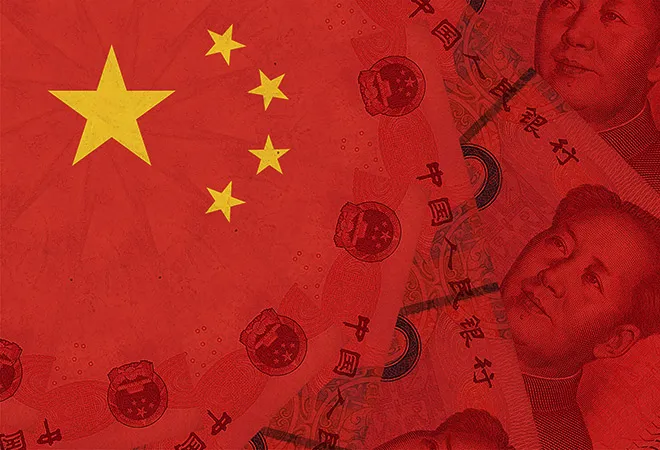 This article is part of the series—Raisina Edit 2022.
This article is part of the series—Raisina Edit 2022.
The Indo-Pacific is home to 65 percent of the world's population, accounts for 63 percent of the
world’s gross domestic product (GDP), and more than 60 percent of the world's maritime trade flows through the region. The economic interests and future growth of many nations, in the region and beyond, are intricately linked to the freedom of navigation and free flow of trade through the Indo-Pacific.
China’s rise as an economic, technological, military, and political powerhouse has resulted in a tectonic shift in the power balance. The tremors are now evident, and their ripples are being felt across the globe. Consequently, it is being argued that managing the rise of a tactfully belligerent China will be critical for the safety, security, and stability of the Indo-Pacific region. A more aggressive China has resulted in the revival of the Quadrilateral Security Dialogue and the announcement of a trilateral security pact (AUKUS). India, Japan, and Australia are emerging power centres and are being viewed as balancing powers in the region.
A more aggressive China has resulted in the revival of the Quadrilateral Security Dialogue and the announcement of a trilateral security pact (AUKUS).
The Russian invasion of Ukraine and the western world’s response thereto have added another dimension to the power struggle in the Indo-Pacific. Closer ties between Beijing and Moscow—as is apparent during the ongoing global divide—could have serious implications in the future. On the other hand, the US is China’s largest trading partner, with China having a huge
bilateral trade surplus (US$396.58 billion). Balancing its trade surplus with the US and relations with Russia will be challenging for China. The western world’s reluctance to directly intervene in the Ukrainian crisis may also embolden China. In this new geopolitical environment, India will have to tread cautiously and navigate the choppy waters carefully.
The 1979 economic reforms ushered in four decades of unparalleled economic growth in China. In 2021,
China’s GDP reached US$17.7 trillion, a US$3 trillion increase over the previous year. At
purchasing power parity, China became the world's
largest economy in 2014, and it is estimated that even in terms of nominal GDP,
it will surpass the US by 2028. China’s sustained economic growth will further strengthen its position in the world order and unipolarity is likely to give way to a bipolar or multipolar world.
After the Gulf War, China embarked on military modernisation. The aim was to have a leaner, meaner, and more effective force, fuelled by a resurgent economy, backed by technology, and self-reliance. The Chinese military has evolved from preparing for localised conflicts to a force capable of projecting and fighting a war beyond its borders. China’s defence expenditure, at US$252 billion (2020), is the
second-largest in the world and is approximately one-third of the US’s defence spending and three-and-a-half times that of India. This phenomenal increase in defence spending is in line with China’s long-term strategy of supporting its national ambition of becoming the world leader. Today, China is a dominant military power and the numerical and technological asymmetry with respect to countries in the Indo-Pacific is growing. China is also building its warfighting infrastructure in the South China Sea and Tibet, which indicates a more belligerent intent. India shares common values, concerns, threat perceptions, and challenges with many nations and therefore, the need to formulate a common strategy. The choices available are to either follow a strategy of engagement, neutrality, or containment. The former will result in economic interdependence and will be mutually beneficial. The peaceful rise of China is what the world hopes for, however, the realists may argue in favour of a strategy of containment, which has the potential to result in a confrontation.
China is a dominant military power and the numerical and technological asymmetry with respect to countries in the Indo-Pacific is growing.
China has territorial disputes with many nations in the region. It has contested Japanese control over the Senkaku Islands and has claimed sovereignty over the South China Sea. It has also engaged in creating artificial islands, constructing airfields, and building military bases in the Parcel and Spratly Islands, which enhance Beijing’s reach/responsiveness and extends the exclusive economic zone. The Philippines, Brunei, Malaysia, Taiwan, and Vietnam have conflicting claim lines in the South China Sea. Taiwan continues to be an unfinished agenda for China and Sino-India relations have reached the tipping point in the aftermath of the
Galwan incident. Each of these flashpoints has the potential to escalate and destabilise the region.
As China moves into post-COVID-19 economic revival, it faces many challenges. The economy is showing signs of slowing down, the corporate sector is at higher levels of indebtedness, the fertility rate (1.702) continues to be
below the replacement rate, the population is ageing, and the advantage of cheap labour is diminishing. China’s debt (US$27 trillion) to GDP ratio stands at 159 percent, which is
60 percent higher than the global average. The integration of Hong Kong, unrest in Xinxiang, and protests in Tibet are ever-festering internal security challenges, which need to be overcome without adverse fallout. A stable economy and equitable distribution of wealth are considered extremely important for the Chinese leadership. Under this backdrop, it will be interesting to watch China’s policy changes, to avoid the “middle-income trap”.
China is the manufacturing hub of the world and the largest oil and gas importer globally. Energy security is considered vital for sustaining its growth. A large majority of crude oil is imported from the Persian Gulf, which is transported through the Malacca Strait. This strategic vulnerability is and will continue to be a source of concern for China. History is replete with examples of the military following trade and, therefore, the deployment of military personnel, to protect China’s economic interests, can be expected in the future.
A stable economy and equitable distribution of wealth are considered extremely important for the Chinese leadership. Under this backdrop, it will be interesting to watch China’s policy changes, to avoid the “middle-income trap”.
The Belt and Road Initiative is President Xi Jinping's flagship programme, intended to expand China’s market by building infrastructure, regional connectivity, and creating economic interdependence. The economic viability of many of these projects—which utilised Chinese labour, material, and funds—has landed recipient nations in a debt trap. The inability of nations to repay the debt has resulted in concessions, detrimental to the national interest. Sri Lanka's reckless borrowing from China to finance infrastructure projects has resulted in the present financial crisis in that country. China has already taken over Hambantota port on lease for 99 years and Sri Lanka is negotiating a debt restructuring.
The Indo-Pacific region is critical to the world economy and security. On one hand, we have the US, which has been a dominant player for many decades. On the other hand, we have China, a rising power that is viewed with suspicion because it threatens the status quo. The Sino-US strategic competition also casts shadow on other countries in the Indo-Pacific. The world may hope for cooperative prosperity and peaceful coexistence. However, an assertive and expansionist China appears to have chosen the path of confrontation. China’s aim has been to regain its lost glory, by dominating Asia in the short term and the world in the future. Therefore, the rise of China will continue to be a challenge for nations in the Indo-Pacific and beyond. Several countries and regional groupings are fence-sitters and watching the scene unfold. They will have to calibrate their responses to protect their national interests while monitoring China’s rise and its intent.
The views expressed above are of the author and it is not a reflection of the government's policy
The views expressed above belong to the author(s). ORF research and analyses now available on Telegram! Click here to access our curated content — blogs, longforms and interviews.



 This article is part of the series—
This article is part of the series— PREV
PREV



